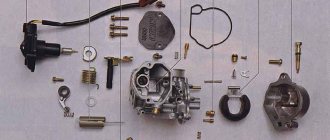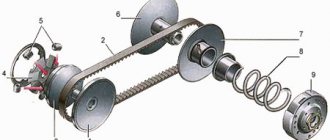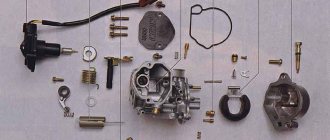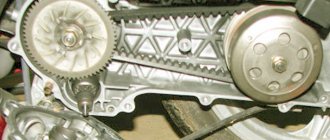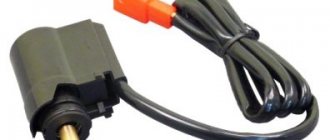Webasto pre-start autonomous engine heater is a compact heater device designed to warm up the engine and interior (or only the interior) of a diesel, and also in some cases, a gasoline vehicle before starting the internal combustion engine. Webasto is an autonomous solution (weight ranges from 3 to 7 kg), connected to the fuel system, electrical on-board network of the vehicle. Also, to warm up the engine, Webasto will be connected to the engine cooling system circuit.
We also recommend reading the article about what a starter charger is. From this article you will learn about how the “booster” works, as well as the advantages of the device and the features of choosing the right solutions of this type.
The presence of a Webasto preheater makes it easier to start a diesel or gasoline engine at low temperatures, reduces wear of loaded parts and increases the engine's service life, reduces the level of exhaust toxicity when starting an internal combustion engine and ensures reduced fuel consumption. It is also worth noting increased comfort, since Webasto provides warm air into the cabin without the need to warm up the engine. Also, the autonomous operation of Webasto means that the battery charge is only partially spent on the operation of the pre-heater, while ensuring subsequent stable engine starting.
What is this?
Engine heaters began to be produced at the beginning of the twentieth century. This work was carried out by Webasto. Since that time, the name of the company has become a household name. Since 1965, the manufacturer began developing automobile air conditioners, and a couple of years later, electric roofs. By the way, the figure that adorns the hood of the Rolls Royce hides inside it using a special mechanism. It is this mechanism that was also developed by Webasto.
Webasto heaters, unlike a standard heating system, do not require the presence of the driver inside the car. The system is able to operate regardless of whether the engine is on or not. With its help, you can preheat the engine and warm up the interior. The system turns on via a programmed timer.
First meeting
The Webasto heater is used by both those who live in particularly cold areas and those whose territories are not characterized by constant frosty weather. But even there there are cold nights and days when the car gets very cold and requires quick warming up before setting off.
Start-up is carried out by a remote control; it can be stand-alone or built into a smartphone or other mobile device; the start time for warming up can be set using a timer, which will allow you to warm up the engine and the entire car without leaving home.
chita.explorer-russia.ru
Webasto heaters have been produced in Germany since 1935, and the company was created 34 years before the start of production of the device.
The name encrypts the name of the owner of WilhEm BAier STOckdorf - Wilhelm Bayer Sr. Since then, the heaters bear the proud name of the company’s founder.
In addition to heaters, the Webasto company produces Webasto car air conditioners, Webasto lifting roofs, which are moved using an electric drive.
Varieties
Having figured out what Webasto is, the driver needs to study the types of heaters. The external design of the device looks like a small combustion chamber operating without a car engine. The operating principle and fuel consumption are different and depend on the type of preheater.
Air type heater - placed in the cabin. It functions like a heat gun, that is, it maintains the desired temperature by blowing hot air.
Liquid - installed under the hood. Activated via timer or remote control. The remote control works within a radius of 1 km. Webasto liquid heats up antifreeze, which heats both the engine and the heater.
The heaters have compact dimensions, so their installation is quite simplified.
How Webasto works
The compact device fits easily into the engine compartment of any car. The Webasto power system is connected to the fuel tank, an autonomous heat exchanger is inserted into the cooling circuit, and to control the operation of the device, a connection is made to the vehicle’s on-board network. Depending on the type of preheater, the principle of operation, as well as fuel consumption during warming up, differs. Devices are:
- Air heaters, whose activity is mainly aimed at warming up the interior, cargo compartment, etc. without turning on the engine, are mounted in the cabin and maintain a comfortable temperature. When transporting goods that require special transportation conditions, Webasto is simply a godsend.
- Liquid heaters installed in the engine compartment serve for autonomous heating of the engine and engine oil, as well as the interior.
How to use
To understand the operating principle of Webasto, you need to remember that the system turns on even when the engine is off. It is activated by the battery, so you should regularly monitor its charge. If the driver rarely uses the car, then he will have to periodically charge the battery, otherwise one fine day the Webasto will not be able to turn on. In order for the interior to warm up completely, the “stove” is set to warm mode. Let's look at ways to manage the system:
Using a timer. Modern devices are equipped with timers. The driver sets the time and date on it, thereby setting the moment of switching on.
Remote control. The device operates within a radius of 1 km, which is very convenient. Through the remote control, the driver independently turns on Webasto. Kits equipped with a remote control have a higher price.
GSM module. This is the most modern control method that the latest devices are equipped with. The driver will be able to control the system via a smartphone, meaning that webasto can be turned on from anywhere in the world. There is no binding within the radius. The program can work on 5 phones simultaneously.
It is necessary to turn on webasto if the outside temperature is low (from -25°C). The system is activated provided that the battery has a normal charge and the antifreeze temperature is less than 140°C. Sometimes webasto does not turn on due to a small amount of fuel in the tank.
Why is there Webasto in the car?
Cars really don’t like low temperatures, especially when their engine is turned off for a long time. Then it can be difficult to launch, if at all possible. But there is a large supply of energy nearby in the form of a fuel tank, why not take advantage of it.
Autonomous heaters come to the rescue - devices that automatically and economically burn a small amount of gasoline or diesel fuel, supplying the resulting heat to the engine cooling system or directly to the car interior.
People who like the cold in their car even less than the engine will find themselves in a heated space after using Webasto, even if only the engine has warmed up.
This is interesting: What is car leasing, the pros and cons of using it
The standard heater fan will quickly create acceptable conditions for passengers. And direct heating from the cabin unit will provide a climate no worse than in summer.
Advantages and disadvantages
As soon as the driver understands Webasto what it is in the car, he becomes interested in whether it is worth installing this system in his car. To understand this, here are a few significant advantages:
An engine that warms up before starting wears out more slowly than when it is turned on “cold”.
Webasto saves time and human health. Getting into the car, the driver is immediately immersed in the comfortable atmosphere of the warm interior. He drives warm, with clean windows, and does not freeze, waiting for the interior to finally warm up.
There is fear among device buyers. They worry that turning on Webasto drains the battery faster. They are worried that the car won't start. Fortunately, such situations almost never happen. The device may not turn on for other reasons.
Additional advantages of the device include a reduction in the volume of harmful exhaust, compactness, light weight, simple design and durable operation. Over the entire period of production of Webasto, the device never overheated, exploded or caught fire.
For some drivers, the device has only one drawback - the high price.
Internal structure and purpose of Webasto
The Webasto autonomous heater has the following structure:
The combustion chamber produces thermal energy.
The pump drives the heated liquid along the motor circuit, which in normal situations is cooling.
The heat exchanger is connected to the cooling system.
The entire complex is controlled by an electronic starter.
t-olimp.ru
Webasto operating principle:
- The remote control turns on the “autonomous” system at a distance of up to 1 km, and the timer can start.
- The air entering the combustion chamber forms a fuel-air mixture. The power of the device is from 3 to 5 kW.
- The glow plug ignites it. Energy is released.
- There is heat in the heat exchanger, transferred by antifreeze.
- The pump pumps the mixture through the cooling system circuit: the device’s heat exchanger transfers it to the car’s radiator and to the engine. It turns on the car's heater - this ensures the interior is warmed, and fans are connected to supply air to the car's windows.
- After half an hour, the optimum temperature of the motor is reached - it turns on without difficulty even at - 40 degrees C.
Price
Each driver can look up the cost of equipment including installation on the Internet. However, in practice the price will differ. The same heater on different cars can differ in price significantly.
For example, all liquid heaters are sold without a control unit. That is why the buyer must first select a control. The cheapest is a timer, the remote control is even more expensive, and the most expensive is the GSM module.
The final cost includes the installation price. However, some Webasto models are very simple, so you can install them yourself. To do this, the driver will need instructions.
Air heater
Webasto heater circuit
Such heaters work on the principle of a heat gun, only the heat source here is not the electricity that heats the coil, but the burning fuel - diesel fuel or gasoline, supplied from the main fuel tank or from a separately installed one. The general diagram of the Webasto autonomous heater looks like this - fuel is supplied to a nozzle inside a special chamber, where it burns, mixing with air. The fan, blowing through the chamber, removes heat from it and supplies heated air to the car interior. These devices have the simplest design, and accordingly they cost less than liquid ones. But their functionality is limited to warming up the interior (van), so such heaters are relevant in temperate climate zones, where there is no problem starting the engine in frosts below -20 degrees, and it is more correct to call them autonomous heaters. Serial installation of such autonomous heaters has long been carried out on domestic passenger military equipment for warming up vans.
Tips for use
Having understood webasto what it is, the driver must not forget that the system, although useful, also burns fuel and releases energy.
Here are some tips for use:
In order for the device to work smoothly, it is necessary to carry out maintenance every 3 months.
If the fuel in the tank is frozen, then the heater, unfortunately, will not work.
It is best to remove the device for the summer or when traveling to a hot region.
Long periods of downtime should not be allowed. The device must be operated regularly.
It is allowed to use the fuel specified in the documents.
Buying a car heater is worth it for those who regularly use a car and live in a region with a cold climate. The high price of the equipment will be paid off by saving fuel and energy.
Webasto heaters work with different types of engines
1zoom.ru
Please note!
Models for different engine types vary
Modifications of Webasto equipment function differently, this is due to the fact that the operating principle and methods of fuel supply are different in different engines.
- Gasoline modifications have a lower starting limit than diesel ones. This is due to the structural features of the fuel used
- Accordingly, diesel modifications consume more diesel fuel than gasoline engines. But this is compensated by two factors: the maximum performance of a diesel engine is higher, and the cost of diesel fuel is lower.
Advantages of Webasto preheaters
Since these products have been produced for decades, the manufacturer has eliminated most of the shortcomings that were in the first modifications. But the equipment can be properly assessed by those who operate their car in cold regions. For someone who drives a car very rarely in winter, and frosts occur infrequently, the device will be of little use.
Those who often use a preheater note the following advantages of the device:
- German-made products are always positioned as premium quality goods, and in this case this is not just a term. Webasto heaters of any modification are reliable and stable;
- Compared to classic warming up of a car using an internal combustion engine, an autonomous device provides fuel savings, and in the first minutes of operation, a warm power unit uses up to 40 percent less fuel;
- When a cold engine starts, it experiences greater loads, which causes many of its parts to wear out more. The pre-start heater increases the service life of the engine by reducing these loads - the oil in a warm internal combustion engine becomes fluid enough to be pumped faster through the channels of the block;
- Webasto buyers are offered a large selection of varieties that allow them to use all the functions of the device that the driver needs;
- There is no need to wait for frozen windows to thaw before traveling;
- If the engine or the system on which its operation depends breaks down, the driver will not freeze in the frosty winter while waiting for the tow truck.
Despite these advantages, the preheater also has several disadvantages. These include the high cost of the equipment itself, as well as installation work. The device operates only by charging the battery, so the power source for “autonomy” must be efficient. Without a fuel heating system (applies to diesel engines), the heater may not work due to the wrong type of fuel.
In conclusion, we offer a short video comparison of the Webasto system and autostart:
AUTOSTART or WEBASTO?
Recommendations for installing Webasto
To avoid getting scammed when installing your device, check for a certificate that can only be issued by an official Webasto representative in Russia. You need to know that the certificate is issued for a certain time, most often for 1 year . The company does not issue permanent certificates.
If the organization had problems with installation or further use by clients, then the manufacturer will not renew this certificate. The certificate must contain the license expiration date.
To check the documents, you can use the official Webasto website, where you can find out whether the organization has the right to install equipment.
The price is dictated by official representatives of the company; it is uniform and differs only between different models. The installer can only change the cost of the work itself.
Selecting the required heater is quite simple:
- Webasto Thermo Top Evo 4 is suitable for diesel and gasoline engines with a displacement of up to two liters;
- Webasto Thermo Top Evo 5 is suitable for diesel and gasoline engines with a displacement of over two liters;
- Webasto Thermo Pro 90 is suitable for commercial vehicles and large diesel engines.
It is recommended to install the heater at a certified service center.
- timer;
- remote control;
- GSM module.
Advantages and disadvantages
I will describe in more detail the advantages and disadvantages of Webasto.
pros:
- Trouble-free engine starting at abnormally low temperatures without unnecessary headaches.
- Warming up the interior and thawing all the windows in the car from ice and snow. This will save time and effort, and also ensure safety (excellent visibility already at the beginning of the trip).
- Significant reduction in engine wear. After all, frequent starting of a cold engine can damage it after a certain time.
- Reducing the amount of emissions and smoke (relevant for diesel engines).
- Light weight of the device (up to 7 kg).
- Durability, reliability and safety of equipment. I note that at the moment, Webasto has been working at the stand in the German manufacturing plant for more than 40 years without stopping, this is how the metal alloy from which the device is made is checked. In the entire history of the Webasto brand, there has not been a single fire due to a faulty device. It is important that the device is certified and the installation is carried out by experienced craftsmen.
- Low fuel consumption to warm up the car. Gasoline consumption for heating Webasto will spend only 250 ml, but the auto alarm system will “eat” as much as 3 liters of fuel overnight.
- In emergency cases, Webasto will heat the interior until the tow truck arrives.
- The device is autonomous and does not introduce any interference into the design of the car. That’s why Webasto is sometimes called “autonomy”. Therefore, you can install different alarms without any problems - they will not interfere with the operation of Webasto. When Webasto is installed in certified centers, the car will remain under warranty.
- You can simultaneously turn on Webasto while the engine is running - it will not overheat. The device must be turned on to warm up the engine when driving a diesel car in order to preserve the battery charge. When the temperature becomes optimal, Webasto will automatically turn off to prevent the motor from overheating. It is important that the technicians install the device properly, then overheating will definitely not happen.
Minuses:
- High cost of device and installation.
- The battery “dies” quickly, which is why the car may not work at all. Although in practice the remaining battery should be enough to start a warm engine. To increase the likelihood of the engine starting, you need to set the fan speed in the car to a minimum (and leave the “stove” itself at maximum), and also use the car for at least 30 minutes after starting to drive.
- If the device runs on diesel fuel, it can often break down when using winter diesel fuel. Therefore, in this case, you will have to install a fuel heater.
How much does this useful unit cost?
The approximate price for liquid Webasto with installation depends on the model and varies from 35 to 90 thousand rubles. An air heater costs less - from 20 to 35 thousand rubles. Used heaters cost 10-15 thousand rubles less.
For example, Webasto Thermo Top Evo START costs 30 thousand rubles, and the most powerful model Webasto Thermo Pro 90 will cost 70 thousand rubles. Prices are shown without installation.
Webasto Thermo Pro 90
What then is the saving? For one hour of operation, Webasto will consume 500-700 ml of fuel. The vehicle heating time does not exceed 30 minutes. The savings here are that very little fuel is spent on warming up the car and the service life of the engine increases. In any case, the cost of the device will pay off in a couple of seasons.
Features of operating a car with Webasto
Webasto in the interior of a minibus
Before installing a pre-heater, first of all, calculate how justified it is in your particular case. If you only use a car every day out of habit, and severe frosts (from minus 25 and below) in your region occur a maximum of ten times during the winter, then it is cheaper to use public transport or a taxi.
The cost of a full-fledged Webasto heater ranges from 30 to 40 thousand rubles (approximately).
It’s another matter if the car is vitally important to you and its daily operation is an objective necessity, especially if the car is a “workhorse”. In this case, for a confident start in winter, installing a Webasto liquid pre-heater will not be a whim.
But the following points must be taken into account:
- the heater will consume battery energy, which will require battery maintenance and, perhaps, replacement;
- Gasoline Webastos “melt” better in severe frosts than those running on diesel fuel;
- Webastos running on diesel engines may fail when operating them on winter diesel fuel, in which case it would be useful to install a fuel heater
- choose the Webasto operating mode so as not to deplete the battery charge.
The fuel consumption of heaters is low - the most powerful ones consume 700 grams per hour of operation. Now you know what Webasto is in a car, how it works and how to avoid poor starting in cold winter.
About the autonomous air heater
Along with the efficiency and high performance of interior air heaters, an important advantage is the low noise level that accompanies the operation of the heater.
Design and principle of operation of an autonomous air heater
A graphic diagram of the autonomous air heater can be found here.
The operating principle and main components of heaters are found in any heater model; below is a video about how the Air Top series air heater works.
Installation and maintenance of Webasto in St. Petersburg
Thus, the operating principle of any Webasto autonomous heater (THERMOTOP PRO 90, THERMOTOP EVO) is to heat the car’s coolant with a burner.
Installation of Webasto preheater
The air heater can be installed on any passenger car. As for water modifications, this depends on the amount of free space under the hood and the possibility of crashing into a small circle of the internal combustion engine cooling system. There is a reason to install Webasta if the car is used daily in cold regions with frosty and long winters.
The cost of the device itself varies from 500 to 1500 dollars. For the work, specialists will charge about 200 more. If the ends justify the means, then the installation of the equipment depends on which vehicle systems it will be synchronized with. The easiest way to install an air modification. To do this, just select a suitable location under the hood and route the heater air duct into the cabin. Some models are mounted directly inside the car. To prevent combustion products from accumulating in the car, the exhaust pipe must be properly routed out.
Before you begin installation work, you should evaluate your capabilities. Since this procedure may involve many complex manipulations with the technical part of the car, it is better to trust a specialist. Despite its simple design, the device operates using an open flame, therefore it is an additional source of ignition. Incorrect connection of elements can lead to the complete destruction of the transport, since the operation of the device is not controlled by anyone.
There are different mounting kits for each engine type (petrol and diesel). Let's look at the features of installing Webasto on both types of engines.
Gasoline internal combustion engine
First, it is necessary to ensure free access to the upper and lower parts of the internal combustion engine cooling system. Without proper lighting, it is impossible to connect the device correctly. The device itself is installed as follows:
- a separate article on how to do this );
- The location where it is best to install the device is selected. It is best to install the liquid modification as close to the engine body as possible. This will make it easier to cut into the small circle of the cooling system. In some car models, the heater can be mounted on the bracket of the windshield washer tank;
- If the installation is carried out on the washer tank mount, then this tank must be moved to another part of the engine compartment. Installing the heater closer to the cylinder block will allow you to obtain maximum efficiency from the device (heat will not be lost during the supply to the main part of the circuit);
- The heater itself must be positioned in such a way relative to the motor and other equipment that neither this device nor the nearby mechanisms and elements are damaged during operation;
- The fuel line must be separate, so the gas tank is removed and the fuel hose is connected to it. The line can be secured next to the main fuel pipes. The heater pump is also installed outside the tank. If a device with an individual tank is used, it must be placed where it will be well ventilated and will not be exposed to strong heat to avoid self-ignition;
- To prevent vibrations from the Webasto fuel pump from being transmitted to the body, a vibration-absorbing gasket must be used at the mounting location;
- The control module is being installed. This small panel can be placed in any place convenient for the driver so that the device can be easily configured, but these buttons cannot be confused with other control buttons located nearby;
- The wiring is connected from the battery to the control unit;
- The pipes are connected to the cold antifreeze inlet and hot antifreeze outlet. At this stage, you need to know exactly how the coolant circulates along the circuit. Otherwise, the heater will not be able to warm up the entire small circuit;
- A pipe is installed to remove exhaust gas. In most cases, it is placed in the wheel arch at the front of the car. The exhaust pipe must be connected to the main exhaust system. Experienced craftsmen recommend making a longitudinal section of the pipe, which will make it easier to seal the pipe - it can be tightened with a metal clamp (since this element has great rigidity, a lot of effort will be required to firmly connect the parts);
- After this, a fuel hose is connected to the heater, and the device itself is fixed in its place under the hood;
- The next stage concerns manipulations with the cooling system. First of all, you need to partially drain the antifreeze in order to lower its level so that it does not spill out during installation;
- The pipes are connected to tees (included in the kit) and clamped with the same clamps as the main pipes;
- Coolant is added;
- Since the device can operate in different modes, it has its own fuse and relay block. It is necessary to find a suitable place where to install this module so that it is not exposed to vibration, high temperature and moisture;
- An electrical line is being laid. In this case, it should be taken into account that the wires are not located on ribbed parts of the body (due to constant vibrations, the harness may fray and contact will be lost). After installation, the wiring is connected to the vehicle’s on-board system;
- Connect the battery;
- Start the internal combustion engine and let it run for about 10 minutes at idle speed. This is necessary in order to eliminate air pockets from the cooling system, and if necessary, antifreeze can be added;
- The final stage is checking the functionality of the pre-heating system.

